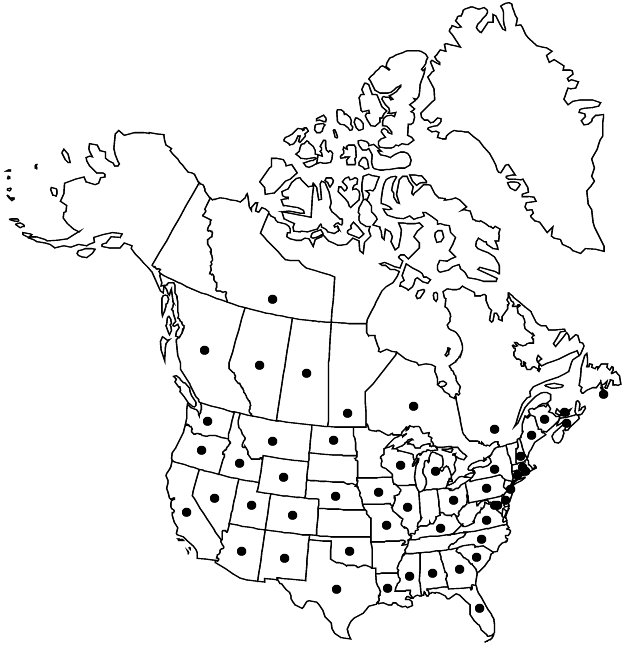Spergularia salina
Fl. ech. 95. 1819.
Plants annual, delicate, 8–25(–30) cm, stipitate-glandular, at least in inflorescence. Taproots ± slender. Stems erect to ascending or prostrate, usually much-branched proximally; main stem 0.6–2(–3) mm diam. proximally. Leaves: stipules inconspicuous, dull white, broadly triangular, 1.2–3.5 mm, longer than wide, apex acute to short-acuminate; blade linear, (0.8–)1.5–4 cm, fleshy, apex blunt to apiculate; axillary leaf clusters usually absent. Cymes simple to 3+-compound or flowers solitary and axillary. Pedicels reflexed and oriented to 1 side in fruit. Flowers: sepals connate 0.5–1 mm proximally, lobes often 3-veined, ovate to elliptic, 2.5–4.5 mm, to 4.8 mm in fruit, margins 0.1–0.5 mm wide, apex acute to rounded; petals white or pink to rosy, ovate to elliptic-oblong, 0.8–1 times as long as sepals; stamens (1–)2–3(–5); styles 0.4–0.7 mm. Capsules greenish to tan, 2.8–6.4 mm, 1–1.5 times as long as sepals. Seeds light brown to reddish brown, with submarginal groove, broadly ovate, ± plump, 0.5–0.7(–0.8) mm, dull, ± smooth, often with gland-tipped papillae (30×); wing usually absent or incomplete. 2n = 18? (Asia), 36 (Europe).
Phenology: Flowering summer–early fall.
Habitat: Mud flats, alkaline fields, sandy river bottoms, sandy coasts, salt marshes, saline highway edges (Great Lakes region)
Elevation: 0-1400 m
Distribution

Introduced and native, St. Pierre and Miquelon, Alta., B.C., Man., N.B., N.W.T., N.S., Ont., P.E.I., Que., Sask., Ala., Ariz., Calif., Colo., Conn., Del., D.C., Fla., Ga., Idaho, Ill., Iowa, Ky., La., Maine, Md., Mass., Mich., Miss., Mo., Mont., Nebr., Nev., N.H., N.J., N.Mex., N.Y., N.C., N.Dak., Ohio, Okla., Oreg., Pa., R.I., S.C., Tex., Utah, Va., Wash., Wis., Wyo., Eurasia, almost cosmopolitan via introduction.
Discussion
While Spergularia salina may be native in coastal areas and some inland saline sites in much of the cited range, populations in the Great Lakes region are introduced where, as in S. media, highway and sidewalk salt runoff has created favorable habitats.
Variety tenuis has been distinguished from var. salina by some authors as follows: cyme crowded versus lax, sepals 1.6–3.8 mm versus 2.4–5 mm, mature capsules 3–4.4 mm versus 3.6–6.4 mm, respectively. Due to the extreme overlap in morphologic features as well as geographic ranges, var. tenuis is not recognized here.
The name Spergularia marina var. leiosperma (Kindberg) Gurke has been applied to plants with smooth seeds but, as pointed out by R. P. Rossbach (1940), separation of plants with smooth versus papillose seeds is not practical.
Some authors believe that the correct name for this species is Spergularia marina.
Selected References
None.